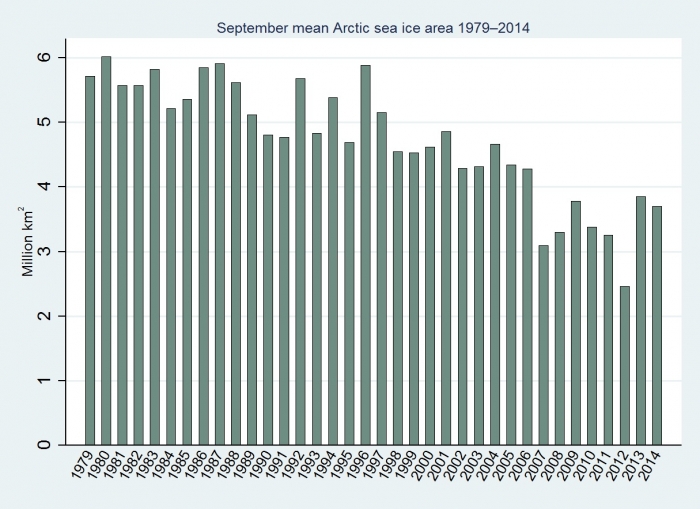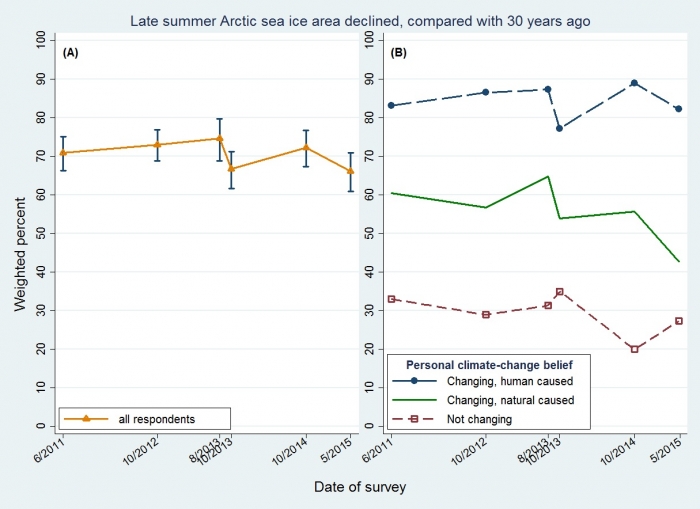By: Lawrence C. Hamilton, Carsey School of Public Policy, University of New Hampshire
The U.S. public knows that something is happening in the Arctic. It involves melting ice, because that has been mentioned in so many news accounts and scientific reports. But where exactly is that ice? Is it still melting? What might that mean for people who live far away? On such points public awareness becomes fuzzy, with some people's perceptions shaped by their ideology instead of geographic or scientific knowledge. These findings emerge from research that has been asking Arctic knowledge questions alongside the usual public opinion or political items on national or statewide surveys.
The first research of this type involved the General Social Survey (GSS), a flagship nationwide instrument supported by the U.S. National Science Foundation. In 2006 and again in 2010, the GSS carried a "polar module" of questions assessing levels of public knowledge about polar regions, and concern about polar climate change. Analysis of those surveys found that knowledge improved slightly from 2006 to 2010, while levels of concern stayed about the same—and were strongly divided in terms of ideology (Hamilton 2008; Hamilton, Cutler and Schaefer 2012a). Ideological divisions prove to be so strong they actually reverse the effects of objectively tested science literacy. Concern about polar climate change tends to increase as science literacy rises among people who self-identify as liberal or moderate. Among the most conservative, however, concern about polar climate change tends to decrease as science literacy rises (Hamilton, Cutler and Schaefer 2012b).
The GSS results inspired a second generation of polar survey research asking more specific questions. In this note we look at one example about Arctic ice:
Which of the following three statements do you think is more accurate? Over the past few years, the ice on the Arctic Ocean in late summer...
- Covers less area than it did 30 years ago.
- Declined but then recovered to about the same area it had 30 years ago.
- Covers more area than it did 30 years ago.
- Don't know/no answer.
Sixty-eight percent of those responding to a 2011 national version of the Community and Environment in Rural America survey (NCERA) knew or guessed the correct answer—ice area has declined. In fact, since 2007 the extent of Arctic sea-ice in September remains over a million square kilometers lower than it was 30 years before. Public recognition of this striking change, however, varies with political orientation and with beliefs about climate change. For example, 80 percent of the NCERA respondents who personally agree with the scientific consensus that climate change is happening now, caused mainly by human activities, answered the sea ice question correctly. On the other hand, only 32 percent of those who think climate change is not happening answered this question correctly. On this and other factual questions, it seems likely that many people chose answers derived from their more general beliefs about climate change (Hamilton 2012).
Figure 1 graphs average Arctic sea ice area, calculated from satellite observations for each September from 1979 to 2014. In 2012, the year after the NCERA survey, ice area reached an historic low point almost three million square kilometers below 1980s levels. The following year, 2013, it recovered somewhat but still remained far below earlier decades.

Would physical events such as the record low ice extent in 2012, or its partial rebound in 2013, affect public perceptions on surveys? What about future Arctic change, which could be even larger? Or possible impacts from other news, and improved science communication? In order to track perceptions over time, in 2011 we started including the same sea ice question on a regular series of statewide New Hampshire surveys. Sixty-eight percent of the respondents on our nationwide NCERA survey had answered this question correctly in 2011; so did 71 percent of those on our statewide New Hampshire survey that year. This follows a pattern seen with later survey comparisons as well: New Hampshire provides an imperfect but not unreasonable proxy for U.S. views. Figure 2A tracks the percent of New Hampshire respondents choosing "ice declined" on six surveys from June 2011 to May 2015 (Hamilton 2015b). There is no trend, although we see an abrupt 8-point drop between August and October 2013. That drop followed news that the September 2013 sea ice area was substantially above its record low point from the previous year. This was confusingly described as a sea ice "recovery" in some media and blogs, even though actual ice area in 2013 was still far below what it had been 30 years before so an "ice declined" response to our question remained unambiguously correct (see Figure 1). By fall 2014, while September sea ice area remained similar to what had been in 2013, survey responses went back to more typical levels with 72 percent selecting "ice declined." All of these fluctuations are within the range of survey sampling uncertainty (shown by vertical bars).

A standard climate-change question on our surveys reads as follows:
Which of the following three statements do you personally believe?
- Climate change is happening now, caused mainly by human activities.
- Climate change is happening now, but caused mainly by natural forces.
- Climate change is NOT happening now.
- Don't know/no answer.
About 52 percent of NCERA respondents, and 55 percent of New Hampshire respondents, agree with the consensus among scientists that climate change is happening now, caused mainly by human activities—again following the pattern of New Hampshire responses a few points warmer than national (Hamilton 2012). Thirty-nine percent nationally and 34 percent in New Hampshire chose the climate changing, natural cause option. Relatively few people on either survey believed that the climate is not changing (5 percent nationally, 6 percent in New Hampshire).
Figure 2B tracks accuracy on the sea-ice question among people who personally believe that climate change is happening now, caused mainly by human activities; happening now, but caused mainly by natural forces; or not happening now. There is a 55-point gap in beliefs about the area of sea ice, comparing those who accept the scientific consensus on climate change with those who believe that the climate is not changing. Indeed the not-changing group performs much worse on the sea ice question than people who say they don't know or express no opinion on climate change: 29 percent accuracy among those who think climate is not changing, vs. 59 percent among those with no opinion about climate change (not graphed in Figure 2).
So what is happening, to produce the strong pattern in Figure 2B? According to the information deficit model of science communication, people express low concern about scientifically-identified problems because they lack information that scientists could provide (Burgess et al. 1998). This model implies that some people do not accept the scientific consensus on anthropogenic climate change because they do not have information, such as Arctic sea ice decline, that scientists know but they don't. An information-deficit explanation might account for the correlation between sea ice and climate beliefs in Figure 2B, but it does not fit other data and is clearly too simple. For one thing, those who express no opinion about climate change are twice as likely to get the sea ice question correct, compared with the climate-not-changing group; and despite admitting ignorance the no-opinion folks are just as accurate about sea ice as the climate-changing-for-natural-reasons group. This and other evidence suggests causality in the opposite direction: people doubt that sea ice has declined because they reject anthropogenic climate change, rather than the other way around.
An alternative to the information deficit model, called biased assimilation, suggests that people tend to seek and retain information that reinforces their prejudices, and reject information that contradicts them (Borick and Rabe 2010; Corner et al. 2011; McCright and Dunlap 2011). Although the reality of anthropogenic climate change is uncontroversial among the great majority of scientists (Doran and Zimmerman 2009; Cook et al. 2013), among the U.S. public it has become a polarized topic (McCright and Dunlap 2011) that correlates more strongly with political identity than almost any other survey question (Hamilton 2014). Another concept helps to understand this polarization: solution aversion, in which people doubt the seriousness of a scientifically-identified problem because they object to its possible solutions (Campbell and Kay 2014). Anthropogenic climate change provides an archetype for solution aversion: its reality is often rejected by people who ideologically oppose governmental solutions. So climate-change beliefs come from more general convictions that filter what scientific information about Arctic change individuals will believe.
What people believe about polar regions, who believes what, and how those beliefs take shape are topics of ongoing research, as we continue tracking results from surveys conducted several times each year. In addition to the sea ice question discussed here, we have other time series on beliefs about whether future Arctic warming will affect weather where you live (Hamilton and Lemcke-Stampone 2014) and whether melting of Arctic sea ice or of the Greenland and Antarctic ice sheets could potentially do more to raise sea level. A new experimental question tests whether people even know that the North Pole is on sea ice (Hamilton 2015b). Results from this research are providing insights on the challenges facing science communication.
Further information about the NCERA survey results is available here.
Further information is available here, or for questions contact Lawrence Hamilton (Lawrence.Hamilton [at] unh.edu).
Acknowledgments
Survey research on polar knowledge and perceptions has been supported by grants from the U.S. National Science Foundation (PoLAR, DUE-1239783; SIPN, PLR-1303938; NH EPSCoR, EPS-1101245), and by the Carsey School of Public Policy and the Sustainability Institute at the University of New Hampshire (UNH). The UNH Survey Center conducted sampling and interviews for all surveys.
References
Borick, C.P. and B.G. Rabe. 2010. "A reason to believe: Examining the factors that determine individual views on global warming." Social Science Quarterly 91(3):777-800.
Burgess, J., C.M. Harrison and P. Filius. 1998. "Environmental communication and the cultural politics of environmental citizenship." Environment and Planning A 30(8):1445-1460.
Campbell, T.H. and A.C. Kay. 2014. "Solution aversion: On the relation between ideology and motivated disbelief." Journal of Personality and Social Psychology 107(5):809-824. doi: 10.1037/a0037963
Cook, J., D. Nuccitelli, S.A. Green, M. Richardson, B. Winkler, R. Painting, R. Way, P. Jacobs and A. Skuce. 2013. "Quantifying the consensus on anthropogenic global warming in the scientific literature." Environmental Research Letters 8. doi:10.1088/1748-9326/8/2/024024
Corner, A., L. Whitmarsh and D. Xenias. 2011. "Uncertainty, scepticism and attitudes towards climate change: Biased assimilation and attitude polarisation." Climatic Change 114(3-4):463-478.
Doran, P.T. and M.K. Zimmerman. 2009. "Direct examination of the scientific consensus on climate change." EOS 90(3):22-23.
Hamilton, L.C. 2008. "Who cares about polar regions? Results from a survey of U.S. public opinion." Arctic, Antarctic, and Alpine Research 40(4):671-678.
Hamilton, L.C. 2012. "Did the Arctic ice recover? Demographics of true and false climate facts." Weather, Climate, and Society 4(4):236-249. doi: 10.1175/WCAS-D-12-00008.1
Hamilton, L.C. 2014. "Do you trust scientists about the environment? News media sources and politics affect New Hampshire resident views." Durham, NH: Carsey School of Public Policy. http://scholars.unh.edu/carsey/213/
Hamilton, L. 2015a. "What people know." Environmental Studies and Sciences 5:54-57. doi: 10.1007/s13412-015-0222-3
Hamilton, L.C. 2015b. "Polar facts in the age of polarization." Polar Geography doi: 10.1080/1088937X.2015.1051158
Hamilton, L.C., M.J. Cutler and A. Schaefer. 2012a. "Public knowledge about polar regions increases while concerns remain unchanged." Durham, NH: Carsey Institute. http://scholars.unh.edu/carsey/157/
Hamilton, L.C., M.J. Cutler and A. Schaefer. 2012b. "Public knowledge and concern about polar-region warming." Polar Geography 35(2):155-168. doi: 10.1080/1088937X.2012.684155
Hamilton, L.C. and M. Lemcke-Stampone. 2014. "Arctic warming and your weather: Public belief in the connection." International Journal of Climatology 34:1723-1728. doi: 10.1002/joc.3796
McCright, A.M. and R.E. Dunlap. 2011. "The politicization of climate change and polarization in the American public's views of global warming, 2001-2010." The Sociological Quarterly 52:155-194.
